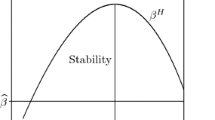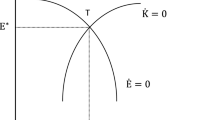Abstract
An important issue in environmental economics is to augment the conventional net national product measure so as to cover changes in stocks of natural resources. In this paper, we show how to treat health (capital) effects in welfare measures caused by, for example, pollution. We also show the effects the risk of “doomsday” caused by pollution has on these measures. A Ramsey growth model enlarged with health capital and death risks is used to derive an augmented welfare measure. A way of solving the particular technical problem one faces when the death risk depends on a state variable (health capital) is also presented. This measure is contrasted with the conventional net national product measure. We also briefly discuss the welfare properties of a market economy when individuals invest in health capital but face a strictly positive death risk.
Similar content being viewed by others
References
T. Aronsson and K.-G. Löfgren, National product related welfare measures in the presence of technological change, externalities and uncertainty, Env. Resource Econ. (1995), to appear.
T. Aronsson and K.-G. Löfgren, Welfare consequences of technological and environmental externalities in the Ramsey growth model, Natural Resource Modeling 7(1993)1–14.
O.J. Blanchard, Debt, deficits, and finite horizons, J. Political Econ. 93(1985)223–247.
O.J. Blanchard and S. Fischer,Lectures on Macroeconimics (The MIT Press, Cambridge, MA, 1989).
P.S. Dasgupta and M. Heal,Economic Theory and Exhaustible Resources (Cambridge University Press, Oxford, 1979).
P.S. Dasgupta and K.G. Mäler,The Environment and Emerging Developing Issues (Wider, Helsinki, 1990), Beijer Institute Reprint Series No. 1 (The Royal Swedish Academy of Sciences, 1991).
M. Grossman,The Demand for Health: A Theoretical and Empirical Investigation, NBER Occasional Paper 119 (National Bureau of Economic Research, New York, 1972).
J.M. Hartwick, Natural resources, national accounting, and economic depreciation, J. Public Econ. 43(1990)291–304.
J.M. Hartwick, Degradation of environmental capital and national accounting procedures, Euro. Econ. Rev. 35(1991)642–649.
R. Lucas, On the mechanics of industrial development, J. Monetary Econ. 22(1988)3–48.
K.G. Mäler, National accounts and environmental resources, Env. Resource Econ. 1(1991)1–15.
P. Romer, Increasing returns and long-run growth, J. Political Econ. 94(1986)1002–1037.
G. Saint-Paul, Fiscal policy in an endogenous growth model, Quart. J. Econ. 107(1992) 1243–1259.
A. Seierstad and K. Sydsaeter,Optimal Control Theory with Economic Applications (North-Holland, New York, 1987).
R.M. Solow, On the intergenerational allocation of natural resources, Scand. J. Econ. 88(1986)141–149.
M. Weitzman, On the welfare significance of national product in a dynamic economy, Quart. J. Econ. 90(1976)156–162.
Author information
Authors and Affiliations
Rights and permissions
About this article
Cite this article
Aronsson, T., Johansson, PO. & Löfgren, KG. Welfare measurement and the health environment. Ann Oper Res 54, 203–215 (1994). https://doi.org/10.1007/BF02031734
Issue Date:
DOI: https://doi.org/10.1007/BF02031734




